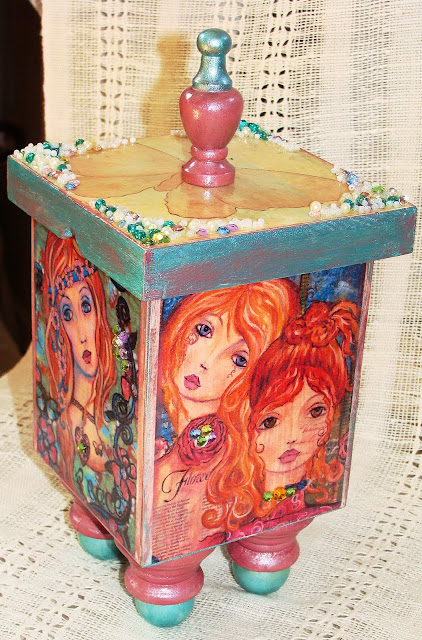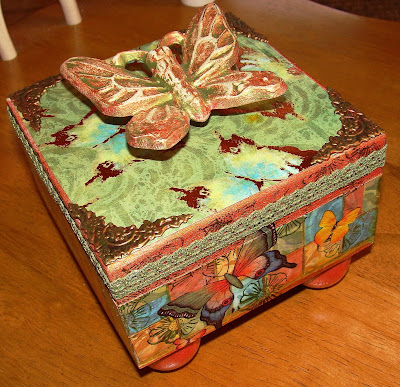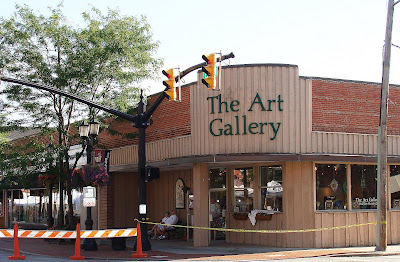Hi everyone--back from my long weekend at my art show. It was in Westlake, Ohio--just outside of Cleveland in a lovely setting on the grounds of St. John's Medical center.
Lots of shoppers and beautiful weather.
And you'll always see all kinds of "shoppers" there too--
So, first off, I wanted to thank everyone for your wonderful comments on my last post, and I also wanted to reply to some of you asking me if I was going to start selling my work online. Well, I'm thinking of starting an Etsy store probably in November--I'm not quite sure about how to set it up, but I know that everyone will help and give me advice when the time comes.
Plus, a few of you have asked me for any help or advice I could give about getting started at selling your art at art/craft shows. So I decided to tell you how I got started and what I've learned throughout the years. I know that it sounds a little intimidating if you've never done this before--but if you just take it in baby steps, it's not so daunting.
The First Step
I started in 1990, and way back then, I didn't even know what a paintbrush was. My craft was florals for many years, which I was very successful with, but after a while, it started to become a job, not a passion. But, that's another story. The first thing I did, and what I feel everyone should do is start small--local craft show in a school or church--a craft/ bazaar show. It really gives you great experience of display, how much you should make and bring. And before that, you can visit the show/shows that you're interested in. Look at the customers--are they just walking around or are they shopping-- and talk to the crafters about the show (are they happy with it) and their overall experience. All crafters are very generous with their help and advice.
Pricing
You can also find items similar to what you sell, and check their prices to stay competitive. I've heard alot of different formulas for pricing, but I feel it depends on where your selling and who you're selling to. Obviously at an art show, you can raise your prices as opposed to a craft show. The customer base is different. I tend to keep my prices on the lower side. I want my art to be affordable so people can purchase it and enjoy it for their own home. It thrills me when people are thrilled to be able to purchase my art. And before I go any further--if you want to start selling your art hoping to support yourself with your sales, then stop reading this, because most likely, you won't. The term "starving artist" is SO true. If I was just doing this for the monetary reasons, then I wouldn't be doing this at all. I'd be in another line of business. All I can say, is that I'm very grateful that my husband has a good enough job to support my "job"!
Display

Another good reason to visit art/craft shows is to get ideas for your display and presentation. It's all about the presentation. Look at the booths that are more crowded. It has ALOT to do with how the artists display their work. I read somewhere that people's attention span is only a few seconds, so you need something to grab their attention, or else they'll just move on to the next booth. The best way to do this is to have your biggest, most impressive piece right out in the front of your booth displayed in a creative way. Some of the display items that I've used throughout the years, I've found, where else, at garage sales and flea markets.
vintage suitcases, shabby small benches covered with linens, preferably vintage

This is a great website if your looking for display items--they can be a little pricey, but they will last forever and they're all collapsible. Here's what the table looks like without anything on it, front and back--
I've had it for almost 20 years--it's the best investment I've made.
And earlier this year I had decided to upgrade my display by getting the artist panels that you see all the time at art shows--a MAJOR investment, but I decided to stay with the lattice panels that I've always used. They just seem to suit my type of art, and I like them. I spray painted them a cream color lightly so they have a white-wash look to them.
Another way of attracting people to enter your booth is to demonstrate your art or craft whatever it may be. People LOVE to watch artists at work, and they'll ask questions, which makes them appreciate what you do that much more--to see what's involved in your art process.
Best Time to Start OutAnd don't give up if you're sales are slow. In these times, people just don't have luxury money anymore. Some barely have enough to pay their bills and buy food for their families. Case in point--the show that I was in this weekend was not that great for sales. It was like that pretty much for all of the artists there too, but this is how it is--you never know what to expect anymore with art shows. But like I said, I'm not in this for the money--I just enjoy the whole art show experience. Don't get me wrong, you can do very well at a show--you just have to find the right ones for you. When I first started out---shows were amazing. It didn't matter what you had to offer (especially in the fall), sales were excellent. But the fall was and always will be the best time to start, because that's when sales are the best.
So I hope I've helped everyone who is thinking about selling their art in art shows. There's more I want to share, but I'll save it for the next post. Remember to email me any questions you might have. My email is on the top of my sidebar.
And on another subject, I want to thank Cheryl Richards from
Artella for publishing my
metal embossing tutorial post in her online magazine, The Art Journal Journey. This is very cool to see an article in a magazine written by me with my name , Diane Salter, right there on the page!--I love it--Thank you Cheryl!

 This really large (over 16" tall) world atlas book filled with many maps, and other great images. And look at the very first and last page!
This really large (over 16" tall) world atlas book filled with many maps, and other great images. And look at the very first and last page!


































.JPG)













.JPG)
